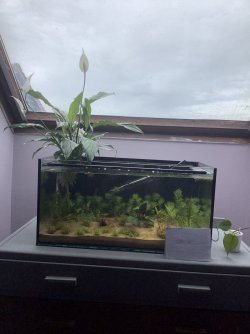I leave the lights on for roughly 12 hours a day and have been dosing fertilizer once a week for the past few weeks.
This is the issue. The light is on for too long, and the additional "fertilizer" is feeding algae. There is more than just diatoms (brown algae) here, so this needs to be rectified (the light/nutrients/plants balance).
New tanks take time to establish the biological stability. During this initial period, algae is always waiting to take advantage of light or nutrients. A good planting of higher plants, and even just some good floating plants, can help a lot in this.
Reduce the light period to 8 hours; it may have to go lower, my tanks are on 7 hours and I have no algae issues, but it took some trial and error to get this sorted out. Use a timer, so it is the same 8-hour period every 24 hours. Make sure there is a continuous period of total darkness as well, which would normally be the 11pm to dawn time of day.
As for fertilizer, Leaf Zone is not sufficient. You want a complete product that includes the 17 necessary nutrients for the plants; some come from the tank/fish, others may need to be supplemented. There are liquid products and substrate tabs. If you can provide the plant names and numbers (a photo of the entire tank planted) we can suggest which.



